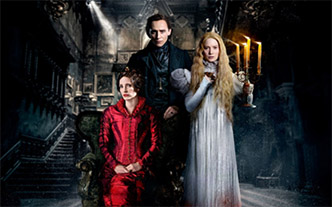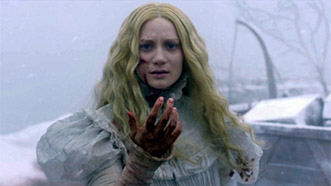Ghosts are real, that much I know. I've seen them all my life..."
I don't know how many times I watched it. Impossible to count. I can say that it is my only favorite among ghost and gothic movies. I may suddenly find myself watching this movie later in the evening. There is a miraculous and magical side that attracts me. Not only did I love every silly, gothic, gorgeous minute of Guillermo del Toro’s Crimson Peak, but I am also actually suspicious of those who didn’t. If you say, “It’s too derivative!”, I will reply, “That’s kind of the point.” And if you say, “It’s not scary enough!”, I will counter with, “Have you ever seen a gothic horror romance?” And if you say, “It’s too beautiful; it is overly art directed!”, I will simply stare at you, agog, and say, “Are you insane?”
Let me tell you a little bit about my favorite movie and my favorite character, Edith Cushing. I don't want to summarize the movie for you. I just wanted to write down why I love this movie so much. This is everything. I hope you can find a lucky time to watch this movie.
"Beware of Crimson Peak," an eerie voice warns Edith. The gothic offering that shares its name with a crumbling mansion atop clay-filled heights is a dark delight that haunts with its unsettling mood and enchants with exquisite imagery. This dark delight makes you realize love how ghosts turned out to be good ones.
 The house is also a character in the film with its missing ceiling, bug infestations, rattling elevator, red clay coming up through the floorboards, and, of course, its ghosts. I have rambled a bit about the look of the film, but it is the most spellbinding element of the film. The ghosts are so brilliant to look at that I find myself admiring their effects of them instead of being outright terrified every single watching. As gruesome as they are ingeniously imagined I find myself watching them very intently and saying in my head “brilliantly done”.
The house is also a character in the film with its missing ceiling, bug infestations, rattling elevator, red clay coming up through the floorboards, and, of course, its ghosts. I have rambled a bit about the look of the film, but it is the most spellbinding element of the film. The ghosts are so brilliant to look at that I find myself admiring their effects of them instead of being outright terrified every single watching. As gruesome as they are ingeniously imagined I find myself watching them very intently and saying in my head “brilliantly done”.
As Crimson Peak's Edith, Mia Wasikowska plays a writer, a Buffalo, New York native, who meets Tom Hiddleston's mysterious, eccentric British aristocrat Sir Thomas Sharpe, and his sister Lucille. Edith is an aspiring novelist. Edith draws comparisons to Jane Austen in Crimson Peak, which she perceives as a slight — she doesn't want to be a romance writer. She prefers horror. (She's in the right movie for that.) Her role model, instead, is Gothic horror writer Mary Shelley, the author best known for Frankenstein. But even when she writes ghost stories instead of romances, these are seen as quaint and endearing rather than terrifying. Unlike Shelley, who was treated as a serious novelist during her lifetime, Edith struggles to be taken seriously. (However, since Shelley's death, the author has been primarily remembered for Frankenstein alone among her written works, and beyond that, as the wife of Percy Bysshe Shelley.)
 Guillermo del Toro tries his elegant best to shake the cobwebs from a musty old genre but still ends up telling a very traditional and predictable haunted house yarn in Crimson Peak. The gifted fantasy/sci-fi/horror specialist has made a film that’s very bloody, and bloody stylish at that, one that’s certainly unequaled in its field for the beauty of its camerawork, sets, costumes and effects. But it’s also conventionally plotted and not surprising or scary at all, as it resurrects hoary horror tropes from decades ago to utilize them in conventional, rather than fresh or subversive, ways.
Guillermo del Toro tries his elegant best to shake the cobwebs from a musty old genre but still ends up telling a very traditional and predictable haunted house yarn in Crimson Peak. The gifted fantasy/sci-fi/horror specialist has made a film that’s very bloody, and bloody stylish at that, one that’s certainly unequaled in its field for the beauty of its camerawork, sets, costumes and effects. But it’s also conventionally plotted and not surprising or scary at all, as it resurrects hoary horror tropes from decades ago to utilize them in conventional, rather than fresh or subversive, ways.
This crimson clay is, at first glance, a symbol of blood and death so obvious. Yet the use of clay as a visual metaphor highlights a central tension in the film. At the same time, the house itself is a repository of memories and specters. This is not only spiritual, but mechanical, as gramophones replay the secrets of the past, paintings capture the severity of a gaze, and Thomas’s inventions seek to penetrate into the ground to recapture the wealth and influence of his ancestors.
In conclusion, “Crimson Peak” is a brilliant, creepy, and very effective supernatural thriller. It always draws me in. If you ask me, Crimson Peak is obviously Del Toro's love letter to romanticism, gothic horror, and good old-fashioned haunted house stories.















